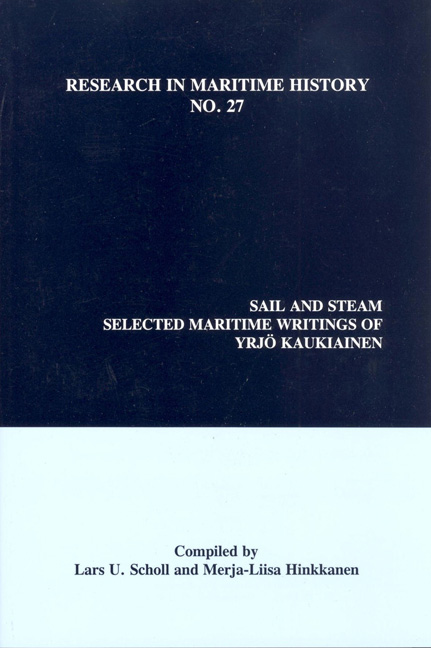Book contents
- Frontmatter
- Frontispiece
- Table of Contents
- Acknowledgements
- “Yrjö Kaukiainen: A Tribute on the Occasion of his Forthcoming Retirement as Professor of Maritime History at the University of Helsinki”
- “Yrjö Kaukiainen: A Man of the Sea”
- “Yrjö Kaukiainen and the Development of Maritime Economic History”
- “Finnish Sailors, 1750-1870”
- “Finnish and International Maritime Labour in the Age of Sail: Was There a Market?”
- “Five Years before the Mast: Observations on the Conditions of Maritime Labour in Finland and Elsewhere”
- “The Maritime Labour Market: Skill and Experience as Factors of Demand and Supply”
- “Owners and Masters: Management and Managerial Skills in the Finnish Ocean-Going Merchant Fleet, c. 1840-1880”
- “From Low-Cost to High-Cost Shipping: Finnish Maritime Labour Costs after the Second World War”
- “The Modernization of Finnish Coastal Shipping and Railway Competition c. 1830-1913”
- “British Timber Imports and Finnish Shipping 1860-1910”
- “Baltic Timber-Trade under Sail: An Example of the Persistence of Old Techniques”
- “Coal and Canvas: Aspects of the Competition between Steam and Sail, c. 1870-1914”
- “Dutch Shipping and the Swedish Navigation Act (1724). A Case Study”
- “Seamen Ashore: Port Visits of Late Nineteenth-Century Finnish Sailors”
- “Wreck-plundering by East Finnish Coastal People - Criminal Tradition or Popular Culture?”
- “From Days and Knots to Pounds and Dollars: Some Problems in the Study of the Economics of Late Nineteenth Century Merchant Shipping”
- “Tons and Tonnages: Ship Measurement and Shipping Statistics, c. 1870-1980”
- “International Freight Markets in the 1830s and 1840s: The Experience of a Major Finnish Shipowner”
- “Shrinking the World: Improvements in the Speed of Information Transmission, c. 1820-1870”
- “Yrjö Kaukiainen: A Maritime Bibliography”
“From Days and Knots to Pounds and Dollars: Some Problems in the Study of the Economics of Late Nineteenth Century Merchant Shipping”
- Frontmatter
- Frontispiece
- Table of Contents
- Acknowledgements
- “Yrjö Kaukiainen: A Tribute on the Occasion of his Forthcoming Retirement as Professor of Maritime History at the University of Helsinki”
- “Yrjö Kaukiainen: A Man of the Sea”
- “Yrjö Kaukiainen and the Development of Maritime Economic History”
- “Finnish Sailors, 1750-1870”
- “Finnish and International Maritime Labour in the Age of Sail: Was There a Market?”
- “Five Years before the Mast: Observations on the Conditions of Maritime Labour in Finland and Elsewhere”
- “The Maritime Labour Market: Skill and Experience as Factors of Demand and Supply”
- “Owners and Masters: Management and Managerial Skills in the Finnish Ocean-Going Merchant Fleet, c. 1840-1880”
- “From Low-Cost to High-Cost Shipping: Finnish Maritime Labour Costs after the Second World War”
- “The Modernization of Finnish Coastal Shipping and Railway Competition c. 1830-1913”
- “British Timber Imports and Finnish Shipping 1860-1910”
- “Baltic Timber-Trade under Sail: An Example of the Persistence of Old Techniques”
- “Coal and Canvas: Aspects of the Competition between Steam and Sail, c. 1870-1914”
- “Dutch Shipping and the Swedish Navigation Act (1724). A Case Study”
- “Seamen Ashore: Port Visits of Late Nineteenth-Century Finnish Sailors”
- “Wreck-plundering by East Finnish Coastal People - Criminal Tradition or Popular Culture?”
- “From Days and Knots to Pounds and Dollars: Some Problems in the Study of the Economics of Late Nineteenth Century Merchant Shipping”
- “Tons and Tonnages: Ship Measurement and Shipping Statistics, c. 1870-1980”
- “International Freight Markets in the 1830s and 1840s: The Experience of a Major Finnish Shipowner”
- “Shrinking the World: Improvements in the Speed of Information Transmission, c. 1820-1870”
- “Yrjö Kaukiainen: A Maritime Bibliography”
Summary
In the history of shipping, the late nineteenth century stands out as an especially interesting and dramatic period. This was not only the era in which steam increasingly challenged and eventually surpassed sail but also the age which witnessed sharp changes in both the economics and business of sea transport. It is hardly surprising that such an epoch has spawned a large number of volumes dealing with ships and seafarers. The result of this approach is that we know quite a bit about the fates of the fastest clippers, the days of the last steel barques, and a host of colourful individuals such as the famed Bully Waterman. It is, I hope, non-contentious to state that the bulk of the extant literature skims only the picturesque and romantic surface of the industry. At the same time, the function and structure of shipping, especially from a quantitative perspective, have been treated much less satisfactorily. We know far too little, for example, about the volume or value of goods transported or the profitability of the industry. Yet as every student knows, shipping was first and foremost an economic activity carried on in the hope of earning profits.
This focus on the anecdotal aspects of the maritime past means, of course, that our understanding of many important topics is both distorted and incomplete. Indeed, it is only in the last decade or so that a “new shipping history” has emerged, especially in a few countries bordering the North Atlantic. While these historians have not ignored traditional questions, they are breaking new ground by compiling quantitative data sets from a variety of under-utilized sources. Some of the main - but not the only - proponents of this new approach to understanding shipping have been associated with the Atlantic Canada Shipping Project in Newfoundland.
It is quite easy to understand why the economics and profitability of shipping have not been popular subjects for maritime historians. Aside from the fact that they lack the romantic appeal of speed records and fail to capture the imagination in the way that descriptions of clipper ships do, these topics are also much more difficult to examine. Even though it is possible to study the economics of shipping without having mastered the technicalities of shipbuilding or sailing, there are other difficulties to be overcome.
- Type
- Chapter
- Information
- Sail and SteamSelected Maritime Writings of Yrjö Kaukiainen, pp. 163 - 178Publisher: Liverpool University PressPrint publication year: 2004



